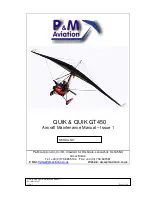
D. The auxiliary terminal is electrically isolated from but mechanically mounted to the heat sink and SRE housing.
It is electrically connected to one end of one stator winding and provides an electrical voltage signal that varies
in a sinusoidal manner with frequency changing directly with speed.
E. A full-wave bridge rectifier is formed from discrete positive and negative diodes mounted within the alternator.
The positive rectifiers are installed in a crescent-shaped aluminum heat sink. The mechanical connection
between the rectifier casings and the heat sink forms the positive electrical connection for the bridge leaving
the heat-sink electrically energized. As such, the heat sink is mounted in a manner that keeps it electrically
isolated from the alternator housings. The alternator’s battery terminal (B+) is mechanically and electrically
connected to the heat sink. The negative rectifiers are installed in the SRE housing, which also acts as a heat
sink. The mechanical connection between the rectifier casings and the housing forms the ground electrical
connection for the bridge. The alternator’s ground terminal is mechanically and electrically connected to the
SRE housing.
F. The rotor assembly is supported by bearings at either end allowing the rotor to spin freely.The bearings are
mounted in the DE and SRE housings. The stator assembly is so arranged within the DE and SRE housings
as to align concentrically with the rotor assembly. The laminated iron core of the stator assembly surrounds
the pole-shoes of the rotor assembly. The slip rings align with the brushes so as to allow one brush to contact
one ring.
G. Most models feature an electrical filter designed to minimize EMI and RFI noise. This filter is a conventional
metal case capacitor with an integrated mounting tab. (Early models may have an internal PCB (printed circuit
board) incorporating a capacitor and gas-dischargetube.) Both types perform the same function and provide
similar performance.
Aircraft Alternator
Maintenance Manual
24-30-01
ES1031
Page: 2-16 Rev.
B: 20 Apr. 2022
© 2022 - Hartzell Engine Technologies - All rights reserved
2.4 Physical Detail
A. The brush holder assembly consists of a brush holder housing and two brush assemblies. The brush
assemblies are made from a carbon-graphite brush having a flexible braided copper wire lead fitted to a coil
spring. Each brush is electrically connected to a separate terminal stud mounted in the brush holder housing.
These studs are the F1 and F2 terminals. The brush holder assembly is mounted in the SRE housing in a
position and manner that allows one brush to ride on each ring providing for a continuous sliding electrical
connection while the rotor spins.
B. The rotor assembly is composed of a shaft, two pole-shoes, a coil assembly and a slip ring assembly. The coil
assembly is a simple enameled-wire coil wound on a bobbin form. The coil is fitted between two iron pole-
shoes which serve as magnetic flux guides. The rotor shaft is pressed through the pole-shoes forming a heavy
interference fit making a permanent assembly fixing the poles in place on the shaft. The slip ring assembly is
composed of two copper rings mounted on a non-metallic, insulating hub. The hub is fixed to the rotor shaft
with one ring electrically connected to each end of the coil assembly winding.
C. The stator assembly is formed by winding three separate coils of enameled copper wire on a common
laminated iron core. The coils are symmetrically spaced around the core and overlap one another. Slot
insulators are used to protect the windings from abrasion damage due to contact with the core. For Wye-
connected stators, one end of each coil is joined in a common connection. The opposite ends of each coil
remain free, resulting in four coil leads emanating from the stator assembly. These leads are electrically
connected to the bridge rectifier network.
















































